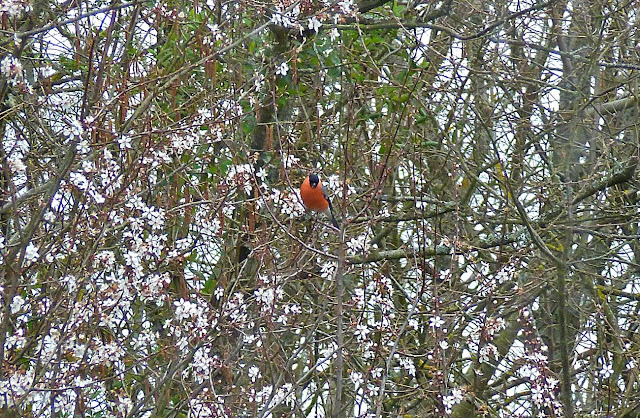At this time in my life, everything seems to have happened, or started, very long ago. I started learning French 50 years ago this year, when I was fourteen and a freshman in high school. Fifty years! I came to France for the first time more than 40 years ago, and 40 years ago on this date I was living and working in Rouen, in Normandy. Then I lived in Paris for a couple of years, in mid-'70s, plus three more years from '79 to '82.
Thirty years ago Walt and I started living together in Washington DC. We had met a couple of years earlier in Paris. That same year, I started working with my friend CHM. Then Walt and I moved to California more than 25 years ago. And, finally, we moved to France ten years ago. See what I mean. Everything happened... started... so long ago...
Our Easter rabbit in its marinade of white wine, herbs, and vegetables
That's the way it is with the Easter rabbit. I won't call it a bunny. We started cooking a rabbit for Easter back around 1984, when we were living and working in DC, because seeing the Easter Bunny everywhere on TV and in stores that spring made us think about eating rabbit the way we had enjoyed eating rabbit in Paris. I think we've had rabbit on Easter every year since then.
So today we are cooking a rabbit, as usual. I'm cooking it in almost the most basic, simple way: « en gibelotte », it's called. That means stewed in white wine with lardons, carrots, onions, herbs, and mushrooms. It's a kind of fricassée, like Coq au vin is a fricassée, but the gibelotte is made with white wine instead of red wine — at least in my version. (The Larousse Gastronomque says a gibelotte is a « fricassée de lapin au vin blanc ou rouge » — but to me the red wine version is more often called a « civet ».)
The recipe I'm basing my Lapin en gibelotte on is Monique Maine's, in Cuisine pour toute l'année (1969). She calls it « Lapin au vouvray ». That's appropriate, since we live near Vouvray, which is on the Loire River less than an hour from here by car, and the first time that we came tp stay fpr twp weeks in the Loire Valley was 12 years ago in Vouvray, in a gîte rural we'd rented for a vacation. That turned out to be a pivotal moment, because we ended up living here not long after the good experience we enjoyed here.
I'll translate and post the recipe tomorrow. The first step is to marinate the rabbit for 6 hours or more in white wine (preferably vouvray, but any dry white wine will do) with the aromatic vegetables. Then you take the rabbit pieces out of the marinade liquid, dry them off with a (paper) towel, and sautée them in butter or olive oil before stewing them in the marinade. You can cook chicken the same way.
I cut the rabbit up yesterday — Walt went to the Saturday market in Saint-Aignan and bought one from our favorite vendor — and put it in to marinate. I'll be doing the cooking part after I come back from my walk with the dog this morning.
The rabbit cut up — two front legs, two hind legs, and the "saddle" (or « râble » in French)
I cut the rabbit up yesterday — Walt went to the Saturday market in Saint-Aignan and bought one from our favorite vendor — and put it in to marinate. I'll be doing the cooking part after I come back from my walk with the dog this morning.



















































